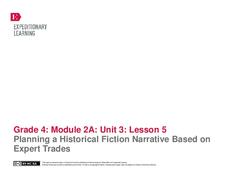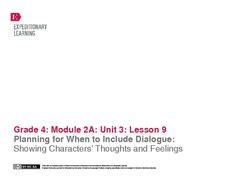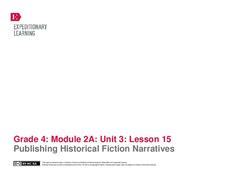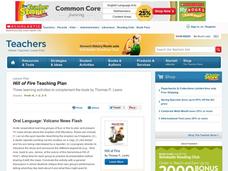Montgomery County Public Schools
Summer Journal Ideas
Twenty prompts, fifteen starters, and ten situations. What more could you ask for from a list of journal ideas?
Curated OER
Language Practice-Grade 5
In this grade 5 language worksheet, students complete a total of 25 multiple choice questions, reading short passages and completing questions. An answer key is included.
Curated OER
Observing Connections: Art, Poetry, and the Environment
Students write poems. In this language arts lesson, students view the works of Edward Hicks. Students write a poem and illustration based on the style of Edward Hicks.
Pennsylvania Department of Education
Informational Writing: Lesson 2 of 5
Introduce expository writing to your elementary learners. Young authors write a three-paragraph informational paper using the steps of the writing process. They follow guided lessons to experience each of five steps. Included are tons of...
EngageNY
Planning Ideas: Developing a Colonial Character Profile
The second lesson in a historical fiction series encourages pupils to develop a character profile of a colonial person using research acquired in the previous unit. Learners prepare their historical fiction narrative by responding to a...
EngageNY
Practice Planning a Historical Narrative: The Wheelwright
Fourth graders use a four-square graphic organizer to plan a paragraph writing about a wheelwright. Using gathered research from the previous unit, young writers discover how to organize a plot in preparation for writing a historical...
EngageNY
Drafting a Historical Fiction Narrative: The Wheelwright
Young writers use the four-square graphic organizer to draft their historical fiction narratives' first, second, third, and fourth paragraphs on the wheelwright. The instructional activity promotes discussion and modeling of what makes a...
EngageNY
Planning a Historical Fiction Narrative Based on Expert Trades
Pupils plan for a historical fiction narrative based on their previous research on expert trades from the Colonial Era. Individuals use the four-square graphic organizer to organize the information they want to be detailed in their four...
EngageNY
Revising for Organization: Timely Transitions
During the eighth lesson in a historical fiction unit, pupils practice thoughtfully transitioning their ideas sequentially. After the teacher models how to add these transitions using the Wheelwright draft created in a previous lesson,...
EngageNY
Revising for Organization and Style: Bold Beginnings
Get young writers thinking about how to write a great beginning for their narratives. After examining examples of solid beginnings in literary text, young writers discuss the criteria for a compelling introduction. Then, independently,...
EngageNY
Peer Critique for Organization and Style
Put another set of eyes on your class's historical fiction narratives with one of the final lessons in the unit. Fourth graders use feedback from their peers to annotate their drafts for revision, particularly their bold beginnings and...
EngageNY
Reviewing Conventions and Editing Peers’ Work
Encourage young writers to edit text based on conventions. After reviewing the conventions, fourth graders watch a teacher demonstrate how to revise a paragraph for correct spelling, capitalization, punctuation, or dialogue. Then, pairs...
EngageNY
Revising for Organization and Style: Exciting Endings
Young writers compose a gripping ending to their historical fiction narratives. Following the previous lesson plan, where learners wrote a bold beginning, class members examine exciting endings from a literary text. They then draft their...
EngageNY
Planning for When to Include Dialogue: Showing Characters’ Thoughts and Feelings
Young writers examine dialogue conventions, including indentation, quotation marks, and expressing thoughts and feelings through a fictional text. By noticing where and when authors use dialogue, they decide how to incorporate dialogue...
EngageNY
Publishing Historical Fiction Narratives
Class members discover what it means to publish their works. Working on a computer, young writers use an online dictionary to edit their spellings and conventions based on the information added to the rubric. From here, and most of the...
Curated OER
You Be the Editor
Young editors work in teams to find all the errors in a text. They identify grammar, punctuation, and spelling errors. Use this activity to reinforce correct usage of prominent punctuation symbols, such as apostrophes and ellipses. You...
Scholastic
Hill of Fire Teaching Plan
Some books are perfect for drawing connections between multiple subjects. The book Hill of Fire becomes the hub for three very different, yet related activity ideas. First the class hones their oral language skills by creating an...
Reed Novel Studies
The Wednesday Wars: Novel Study
Teacher's pet or enemy? Holling, a character in The Wednesday Wars, feels his teacher is out to get him. However, he has to remain on his best behavior to ensure his father's business does not suffer. How will he ever survive 7th grade?...
Curated OER
Descriptive Writing Using the Book Rumpelstiltskin
Use the fairy tale Rumpelstiltskin to teach your third grade class about descriptive writing. Following a teacher read-aloud of the story, the class brainstorms a list of adjectives describing the main character. Students use this list...
Frank Macias Elementary School
Preparing for Guided Reading
Take your guided reading lesson plans to the next level with a collection of printables, templates, and reference tools equipped to support the reading needs of your readers. Included is a detailed information page, grouping sheet,...
Curated OER
Persuasive Writing
Use a quick bell-ringer to interest your class in the art of persuasion. They brainstorm where they find examples of persuasion in their lives and identify who is trying to persuade them. Then they either fish through magazines or look...
Reed Novel Studies
The Incredible Journey: Novel Study
There's no place like home. Three family pets prove this in The Incredible Journey as they head out to find their way back home. Scholars read about the dangers the pets face on their journey while they learn eight vocabulary words from...
Reed Novel Studies
Paperboy: Novel Study
Little Man, in Vince Vawter's Paperboy, is a great baseball player, but due to stuttering he'd rather not speak to a soul. Scholars read how Little Man deals with his fears as they use vocabulary words to complete sentences, answer seven...
Reed Novel Studies
Skink No Surrender: Novel Study
The oldest turtle ever recorded lived to the age of 188! As it turns out, two characters from Carl Hiaasen's Skink No Surrender are fascinated by these shelled creatures. Using the novel study, scholars research three types of turtles...






















